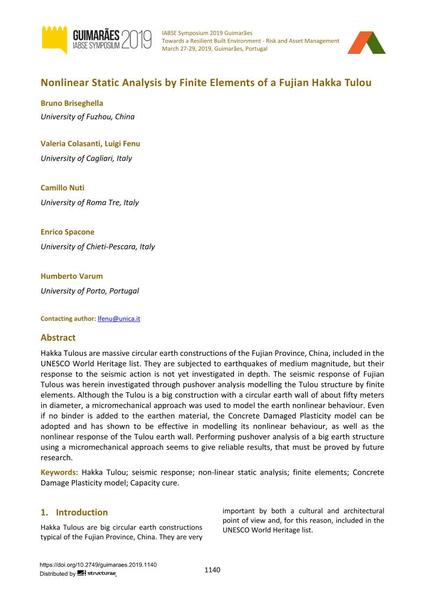Nonlinear Static Analysis by Finite Elements of a Fujian Hakka Tulou

|
|
|||||||||||
Bibliografische Angaben
| Autor(en): |
Bruno Briseghella
Valeria Colasanti (University of Cagliari, Italy) Luigi Fenu (University of Cagliari, Italy) Camillo Nuti Enrico Spacone (University of Chieti-Pescara, Italy) Humberto Varum |
||||
|---|---|---|---|---|---|
| Medium: | Tagungsbeitrag | ||||
| Sprache(n): | Englisch | ||||
| Tagung: | IABSE Symposium: Towards a Resilient Built Environment Risk and Asset Management, Guimarães, Portugal, 27-29 March 2019 | ||||
| Veröffentlicht in: | IABSE Symposium Guimarães 2019 | ||||
|
|||||
| Seite(n): | 1140-1147 | ||||
| Anzahl der Seiten (im PDF): | 8 | ||||
| DOI: | 10.2749/guimaraes.2019.1140 | ||||
| Abstrakt: |
Hakka Tulous are massive circular earth constructions of the Fujian Province, China, included in the UNESCO World Heritage list. They are subjected to earthquakes of medium magnitude, but their response to the seismic action is not yet investigated in depth. The seismic response of Fujian Tulous was herein investigated through pushover analysis modelling the Tulou structure by finite elements. Although the Tulou is a big construction with a circular earth wall of about fifty meters in diameter, a micromechanical approach was used to model the earth nonlinear behaviour. Even if no binder is added to the earthen material, the Concrete Damaged Plasticity model can be adopted and has shown to be effective in modelling its nonlinear behaviour, as well as the nonlinear response of the Tulou earth wall. Performing pushover analysis of a big earth structure using a micromechanical approach seems to give reliable results, that must be proved by future research. |
||||
| Stichwörter: |
finite Elemente
|
||||
